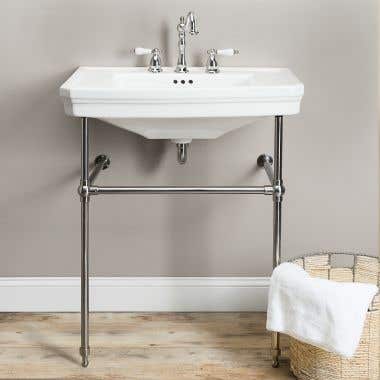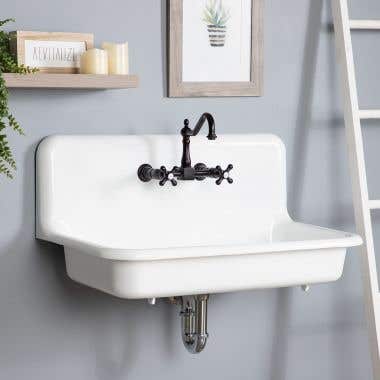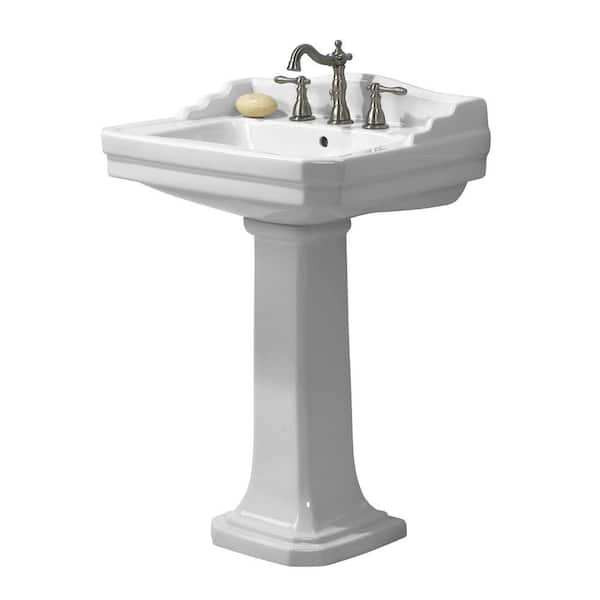The Evolution of Bathroom Sink Design in the 1930s
The 1930s marked an era of significant change and innovation in bathroom sink design. As indoor plumbing became more common in households, manufacturers began to experiment with new styles and features. Let’s discuss the evolution of bathroom sink design during the 1930s, highlighting the key trends and advancements that shaped this period.
- Streamlined Silhouettes: One of the prominent features of 1930s bathroom sinks was their streamlined silhouettes. Inspired by the Art Deco movement, sinks of this era featured sleek lines and geometric shapes. The focus was on minimalistic and functional designs that integrated well into the overall aesthetic of the bathroom.
- Pedestal Sinks: Pedestal sinks gained popularity during the 1930s, offering a stylish and space-saving solution. These sinks were characterized by a basin supported by a slender pedestal, providing an elegant and decorative element to the bathroom. Pedestal sinks were favored for their timeless appeal and ability to complement various design styles.
- Colorful Fixtures: In the 1930s, bathroom sinks started to embrace color. Manufacturers experimented with vibrant hues like pastel pinks, blues, and greens, allowing homeowners to add a pop of color to their bathrooms. These colorful fixtures added a touch of personality and charm to the space, departing from the more traditional white porcelain sinks of previous decades.
- Integrated Storage: As storage became a growing concern, bathroom sinks in the 1930s began incorporating built-in cabinets or shelves. These innovative designs allowed homeowners to keep their toiletries and essentials within reach while maintaining a clutter-free countertop. The integration of storage options was a significant step towards enhancing the functionality of the bathroom.
- Improved Durability: With advancements in manufacturing techniques, bathroom sinks in the 1930s became more durable and long-lasting. Manufacturers began using vitreous china, a material known for its strength and resistance to stains and scratches. This shift towards more robust materials ensured that sinks could withstand the test of time and continued use.

Exploring the Unique Characteristics of 1930s Bathroom Sinks
1930s bathroom sinks were known for their unique and iconic features that set them apart from sinks of other eras. Let’s take a closer look at the distinctive characteristics that defined 1930s bathroom sinks, showcasing their beauty and functionality.
Deco-Inspired Faucets: One of the standout features of 1930s bathroom sinks was the faucets. Inspired by the Art Deco movement, faucets during this period often featured sleek and angular designs. The handles were commonly made of Bakelite, a synthetic material that was popular during the time. These faucets added a touch of elegance and sophistication to the overall sink design.
Ornate Backsplashes: Many 1930s bathroom sinks boasted ornate and decorative backsplashes. These often featured intricate tile work or embossed patterns, adding a sense of luxury and refinement to the sink area. The backsplash not only served the practical purpose of protecting the wall from water damage but also became a focal point in the bathroom.
Elaborate Basin Shapes: The 1930s saw a departure from the traditional round or oval-shaped basins. Sinks of this era often featured more geometric shapes, such as rectangular or angular basins. Some sinks even incorporated multiple basins, allowing for simultaneous use by multiple people. These unique basin shapes added visual interest and functionality to the sink design.
Integrated Towel Bars: To maximize space and convenience, many 1930s bathroom sinks were equipped with integrated towel bars. These towel bars were often attached to the sides of the sink or incorporated into the design of the pedestal. They provided a practical solution for hanging towels, ensuring they were easily accessible after handwashing.
Artistic Details: In addition to their functional elements, 1930s bathroom sinks were infused with artistic details. Some sinks featured hand-painted designs or intricate engravings, showcasing the craftsmanship and attention to detail of the era. These artistic touches added a sense of individuality and character to each sink, making them truly one-of-a-kind.
A Look into the Craftsmanship of 1930s Sink Manufacturing
The craftsmanship and attention to detail in 1930s sink manufacturing played a significant role in shaping the durability and quality of these bathroom fixtures. Let’s explore the materials used and construction techniques employed during this era, highlighting the craftsmanship that went into creating 1930s bathroom sinks.
Vitreous China: Vitreous China emerged as the primary material for 1930s bathroom sinks. This ceramic material was known for its durability and resistance to stains and scratches, making it an ideal choice for sink manufacturing. The vitreous china was fired at high temperatures, resulting in a dense and hard surface that could withstand everyday use.
Cast Iron Framework: To provide stability and support, many 1930s sinks featured a cast iron framework. This framework served as the base for the sink, ensuring its strength and durability. The cast iron construction allowed for the integration of various components, such as the pedestal or built-in storage, providing a solid foundation for the sink.
Enamel Finishes: To enhance the aesthetics of 1930s bathroom sinks, enamel finishes were commonly applied. These finishes not only added a glossy sheen to the sink but also provided an extra layer of protection against chipping and scratching. The enamel finishes were carefully applied by skilled craftsmen, resulting in a smooth and lustrous surface.
Handcrafted Details: 1930s bathroom sinks were often characterized by intricate and handcrafted details. Skilled artisans meticulously carved and shaped the sink components, paying attention to every curve and line. From the delicate edges of the basin to the ornate patterns on the pedestal, these handcrafted details added a sense of artistry and elegance to the sink design.
Seamless Integration: A hallmark of 1930s sink construction was the seamless integration of various components. Whether it was the pedestal, backsplash, or storage cabinets, great care was taken to ensure that these elements seamlessly blended with the sink itself. This meticulous attention to detail resulted in a cohesive and visually pleasing sink design.
How the Style of the Era Transformed Bathroom Sink Design
The Art Deco movement of the 1930s had a profound influence on various aspects of design, including bathroom sink design. Let see how the distinctive style of Art Deco transformed bathroom sink design during this era, leaving a lasting impact on the aesthetics and functionality of these fixtures.
Geometric Shapes: Art Deco design is characterized by its emphasis on geometric shapes, and this influence is evident in 1930s bathroom sinks. Sinks of this era often featured angular and streamlined silhouettes, with straight lines and sharp corners. The geometric shapes added a sense of modernity and sophistication to the sink design, reflecting the spirit of the Art Deco movement.
Luxurious Materials: Art Deco was known for its embrace of luxurious materials, and this translated into bathroom sink design as well. 1930s sinks often incorporated materials like marble, chrome, and glass, adding a touch of opulence to the space. These materials were carefully selected for their aesthetic appeal and durability, elevating the overall look and feel of the sink.
Bold Colors and Patterns: Art Deco design was bold and vibrant, and this was reflected in the color choices and patterns of 1930s bathroom sinks. Sinks of this era often featured rich and deep colors like black, gold, and deep blues. Patterns such as sunbursts, chevrons, and geometric motifs were also common, adding visual interest and a sense of dynamism to the sink design.
Streamlined Faucets: Art Deco influenced not only the overall shape of the sink but also the design of the faucets. Faucets during this era often featured sleek and streamlined designs, with long and slender spouts. The handles were often geometrically shaped, mirroring the overall aesthetic of the sink. These faucets added a touch of elegance and refinement to the sink area.
Emphasis on Functionality: While Art Deco design was known for its emphasis on aesthetics, it also prioritized functionality. This was evident in 1930s bathroom sink design, where the streamlined shapes and integrated storage options were designed to optimize space and convenience. The sinks were not only visually appealing but also practical and efficient in their use.
Tips and Tricks for Preserving and Reviving 1930s Bathroom Sinks
Preserving and reviving 1930s bathroom sinks requires careful attention and restoration techniques to maintain their original charm and functionality. Here are several tips and tricks for restoring these vintage sinks, ensuring they can be enjoyed for years to come.
Research and Documentation: Before embarking on a restoration project, it is important to research and gather information about the specific sink model and its original design features. Look for vintage catalogs, advertisements, or photographs from the 1930s to understand how the sink would have originally looked. This will guide your restoration process and help you maintain the authenticity of the sink.
Cleaning and Maintenance: Begin the restoration process by thoroughly cleaning the sink. Use a mild detergent and warm water to remove dirt and grime. Avoid abrasive cleaners that can damage the finish. For tough stains, consider using a gentle cleaning solution specifically designed for vintage sinks. Regular maintenance should include wiping the sink dry after each use to prevent water spots and mineral deposits.
Repairing Chips and Scratches: Over time, 1930s sinks may develop chips or scratches. To repair minor chips, use a porcelain repair kit that matches the color of the sink. Gently fill in the chip and smooth it out with fine-grit sandpaper. For deeper scratches, consult a professional restoration expert who can provide specialized repair techniques.
Restoring the Finish: If the original finish of the sink has faded or been damaged, consider restoring it to its former glory. Seek out professional refinishing services that specialize in vintage fixtures. They can strip off the old finish and apply a new one, ensuring the sink looks as close to its original condition as possible. Be sure to choose a finish that matches the era and style of the sink.
Finding Authentic Accessories: To complete the restoration, consider adding authentic accessories to enhance the vintage look of the sink. Look for period-appropriate faucets, handles, and towel bars that match the style and era of the sink. Antique stores, salvage yards, and online marketplaces can be excellent sources for finding these authentic accessories.
Displaying and Using the Sink: Once the restoration is complete, carefully position the sink in a prominent place in your bathroom. Consider creating a cohesive design by incorporating other vintage elements or period-inspired decor. While it may be tempting to treat the sink as a decorative piece, it is important to remember that it is fully functional. Use it regularly to ensure its plumbing remains in good working condition.
1930u0027s Series Wall Mounted/Pedestal Basins
Vintage Bathroom Sinks Vintage Tub u0026 Bath
1930u0027s Vintage Standard Cast Iron Pedestal Sink
Series 1930 Lavatory and Pedestal Combo in White
1930s reproduction sink for a bungalow, four-square or romantic
1930s Bathroom: 5 Best Design Ideas for a 1930 Bathroom Renovation
1930s bathroom
1930 – Toilets, Sinks & More Duravit
Related Posts:











